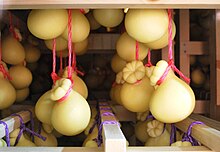Caciocavallo
As Caciocavallo one is cheese from cow's milk or sheep's milk referred.
General
The recipe for this Italian cheese is very old - the exact origin of the name is therefore uncertain. Whether the cheese (Latin caseum > early Italian cacio , but Italian formaggio = cheese) was allowed to mature in pairs like saddlebags on horseback (Italian: cavallo = horse), dried in a horse bladder or made from mare's milk can no longer be clarified today. A currently discussed theory connects the origin of the name with an old Turkish cheese called " Kaschkaval ", from which "Caciocavallo" can be derived onomatopoeically . Today cheese has the shape of a ball, a drop or an oval bag. The color of the smooth bark darkens as it ripens. The cheese itself is white to straw yellow, depending on its maturity. The taste is mild, almost sweet.
Manufacturing
Calf rennet or goat rennet is added to fresh cow's milk at 36 ° C. The resulting curd is chopped up and separated from the whey . The cheese stays there for three days. The cow - or sheep's milk cheese is a pasta filata formed thread in a sense, be a wooden mandrel and giving it its characteristic pear shape. The rider cheese from Roman times with its 44% fat i. Tr. can also be enjoyed young and mild and becomes the ideal grated and processed cheese between six and twelve months. The cheese is made in the Italian regions of Sicily , Basilicata , Campania , Molise , Abruzzo , Apulia and Calabria .
use
The cheese is eaten with salads, on pizzas or with pasta . In Puglia it is occasionally available hot as a roast cheese in restaurants, either as a side dish (Contorno) or as a main course (Secondo piatto). Good, sweet white wines are suitable as a wine.
literature
- Udo Pini : Das Gourmet Handbuch, Könemann, Cologne 2005, ISBN 3-8290-1443-0 , current edition: at Ullmann bei Tandem, Königswinter 2007 (6th edition), ISBN 978-3-8331-4302-1 .
- Fabiano Guatteri: Cheese , original title: Formaggi translated by Maria Schlick, Kaiser, Klagenfurt 2005, ISBN 3-7043-1419-6
